The Minnesota Daily is the campus newspaper of the University of Minnesota, published Monday and Thursday while school is in session, and published weekly on Wednesdays during summer sessions. Published since 1900, the paper is currently the largest student-run and student-written newspaper in the United States and the largest paper in the state of Minnesota behind the Minneapolis Star Tribune and the St. Paul Pioneer Press. The Daily was named best daily college newspaper in the United States in 2009 and 2010 by the Society of Professional Journalists. The paper is independent from the University, but receives $500,000 worth of student service fees funding.

The Young People's Society of Christian Endeavor was founded in Portland, Maine, in 1881 by Francis Edward Clark, as an interdenominational Christian youth society encouraging them to "work together to know God in Jesus Christ". Operating internationally as World's Christian Endeavor Union, the society's professed objective is "to promote an earnest Christian life among its members, to increase their mutual acquaintanceship, and to make them more useful in the service of God."
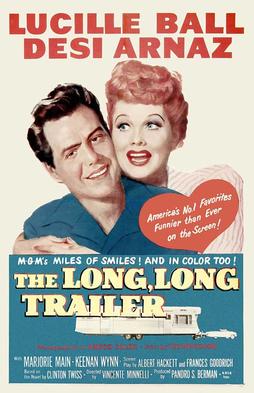
The Long, Long Trailer is a 1954 American Anscocolor road comedy film based on a novel of the same name written by Clinton Twiss in 1951 about a couple who buy a new travel trailer home and spend a year traveling across the United States.

Maud Hart Lovelace was an American writer best known for the Betsy-Tacy series.
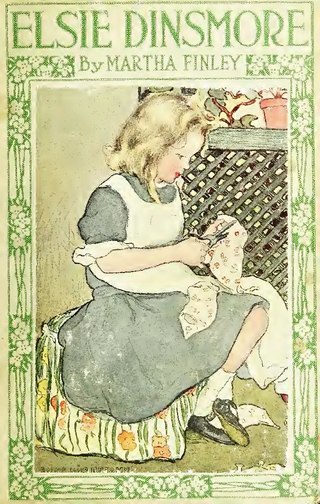
Elsie Dinsmore is a children's book series written by Martha Finley (1828–1909) between 1867 and 1905. Of Finley's two girls' fiction series, the "Mildred Keith" books were more realistic and autobiographical in nature, while the "Elsie Dinsmore" books, which were better sellers, were more idealistic in plot. A revised and adapted version of the Elsie books was published in 1999.
Thomas Y. Crowell Co. was a publishing company founded by Thomas Y. Crowell. The company began as a bookbindery founded by Benjamin Bradley in 1834. Crowell operated the business after Bradley's death in 1862 and eventually purchased the company from Bradley's widow in 1870.
The Betsy-Tacy books are a series of semi-autobiographical novels by American novelist and short-story writer Maud Hart Lovelace (1892-1980), which were originally published between 1940 and 1955 by the Thomas Y. Crowell Co. The books are now published by HarperCollins. The first four books were illustrated by Lois Lenski and the remainder by Vera Neville.

Betsy-Tacy (1940) is the first volume in the Betsy-Tacy series by Maud Hart Lovelace.
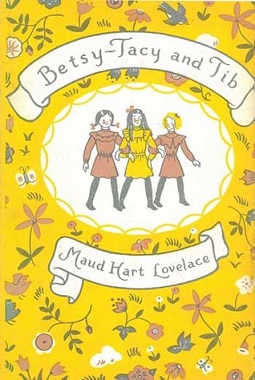
Betsy-Tacy and Tib (1941) is the second volume in the Betsy-Tacy series by Maud Hart Lovelace. The book, along with the entire Betsy-Tacy and Deep Valley series, was republished in 2000 by HarperTrophy with a new cover art illustrated by Michael Koelsch.

Betsy and Tacy Go Over the Big Hill (1942) is the third volume in the Betsy-Tacy series by Maud Hart Lovelace. The book, along with the entire Betsy-Tacy and Deep Valley series, was republished in 2000 by HarperTrophy with a new cover art illustrated by Michael Koelsch.

Betsy and Tacy Go Downtown (1943) is the fourth volume in the Betsy-Tacy series by Maud Hart Lovelace. The book, along with the entire Betsy-Tacy and Deep Valley series, was republished in 2000 by HarperTrophy with a new cover art illustrated by Michael Koelsch.

Heaven to Betsy (1945) is the fifth volume in the Betsy-Tacy series by Maud Hart Lovelace. Heaven to Betsy, describing Betsy's first year in high school, is written for an older age group than the earlier Betsy-Tacy books. The book, along with the entire Betsy-Tacy and Deep Valley series, was republished in 2000 by HarperTrophy with a new cover art illustrated by Michael Koelsch.
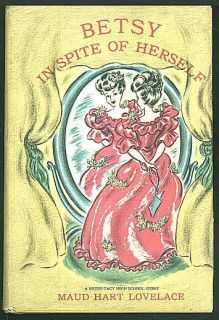
Betsy in Spite of Herself (1946) is the sixth volume in the Betsy-Tacy series by Maud Hart Lovelace. The book, along with the entire Betsy-Tacy and Deep Valley series, was republished in 2000 by HarperTrophy with a new cover art illustrated by Michael Koelsch.

Betsy Was a Junior (1947) is the seventh volume in the Betsy-Tacy series by Maud Hart Lovelace. The story spans the title character's junior, or eleventh grade, year in high school. The book, along with the entire Betsy-Tacy and Deep Valley series, was republished in 2000 by HarperTrophy with a new cover art illustrated by Michael Koelsch.

Betsy and Joe (1948) is the eighth volume in the Betsy-Tacy series by Maud Hart Lovelace. This installment spans the title characters' senior, or twelfth grade, year in high school. The book, along with the entire Betsy-Tacy and Deep Valley series, was republished in 2000 by HarperTrophy with a new cover art illustrated by Michael Koelsch.
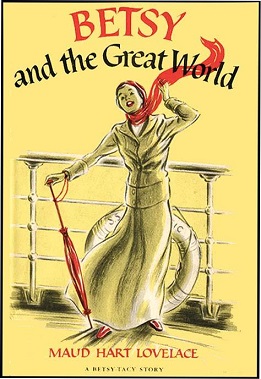
Betsy and the Great World (1952) is the ninth volume in the Betsy-Tacy series of children's fiction by Maud Hart Lovelace. The book, along with the entire Betsy-Tacy and Deep Valley series, was republished in 2000 by HarperTrophy with a new cover art illustrated by Michael Koelsch.
Betsy is an English feminine given name, often a nickname for Elizabeth.
The Mother-Daughter Book Club is a series of children's novels written by Heather Vogel Frederick. The books center around the lives of five different preteens, and eventually teenage girls who become best friends because of the book club that their mothers start. The girls live in a slightly fictionalized Concord, Massachusetts.

Kathleen Palmer Hart Bibb Foster was an American concert singer and voice teacher. She was also the model for the character "Julia Ray" in the popular Betsy-Tacy book series, written by her younger sister.

The Betsy-Tacy Houses are a pair of historic houses in Mankato, Minnesota that were the childhood homes of author Maud Hart Lovelace and her childhood friend, Frances Kenney. Lovelace used these houses as inspiration for the settings of her "Betsy-Tacy" book series. The houses are owned and operated together as a museum by the Betsy-Tacy Society.















